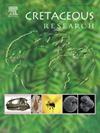智利中部Río Volcán剖面,neuquemassn盆地西部Baños Morales组和Lo valdsamas组侏罗纪/白垩系界线上calpionellids和钙质鞭毛藻囊的微相与生物地层学研究
IF 1.7
3区 地球科学
Q1 GEOLOGY
引用次数: 0
摘要
本研究首次对智利中部(34°S) Principal Cordillera的Tithonian-Hauterivian Baños Morales组和Lo vald本文章由计算机程序翻译,如有差异,请以英文原文为准。
Microfacies and biostratigraphy based on calpionellids and calcareous dinoflagellate cysts across the Jurassic/Cretaceous boundary, western Neuquén Basin, Baños Morales and Lo Valdés formations, Río Volcán section, Central Chile
This study presents the first biostratigraphic analysis of calpionellids and calcareous dinoflagellate cysts in the Tithonian–Hauterivian Baños Morales and Lo Valdés Formations, which crop out in the Principal Cordillera of central Chile (34°S). Additionally, it provides a preliminary interpretation of the sedimentary environment based on microfacies analysis. The Baños Morales and Lo Valdés Formations form an ∼800 m thick succession of basinal marlstone, sandstone and limestone, shallow-water limestones and thick intercalations of lavas, which developed on the western margin of the Neuquén Basin. The Baños Morales and Lo Valdés Formations are characterized by an abundant fossil content, a remarkable stratigraphic continuity along several hundred meters, and include the Jurassic/Cretaceous boundary. The detailed study of its type section (Baños Morales town, Volcán river), allowed the identification of a moderately to poorly preserved association of seventeen calpionellid species and fifteen calcareous dinoflagellate cyst species and four subspecies. Six calpionellid biozones (Chitinoidella, Crassicollaria, Calpionella, Calpionellopsis, Calpionellites and Tintinnopsella) and eight calcareous dinoflagellate cyst biozones (Committosphaera pulla, Crustocadosina semiradiata, Colomisphaera tenuis, Colomisphaera fortis, Stomiosphaerina proxima, Stomiosphaera wanneri, Colomipshaera vogleri, and Colomisphaera conferta), already known from the Tethyan and Andean regions, have been identified, enabling a more precise stratigraphic calibration for the Baños Morales and Lo Valdés Formations, as well as their stratigraphic correlation with the stratigraphic units of Argentina and international time scales.
求助全文
通过发布文献求助,成功后即可免费获取论文全文。
去求助
来源期刊

Cretaceous Research
地学-地质学
CiteScore
4.10
自引率
19.00%
发文量
235
审稿时长
12 weeks
期刊介绍:
Cretaceous Research provides a forum for the rapid publication of research on all aspects of the Cretaceous Period, including its boundaries with the Jurassic and Palaeogene. Authoritative papers reporting detailed investigations of Cretaceous stratigraphy and palaeontology, studies of regional geology, and reviews of recently published books are complemented by short communications of significant new findings.
Papers submitted to Cretaceous Research should place the research in a broad context, with emphasis placed towards our better understanding of the Cretaceous, that are therefore of interest to the diverse, international readership of the journal. Full length papers that focus solely on a local theme or area will not be accepted for publication; authors of short communications are encouraged to discuss how their findings are of relevance to the Cretaceous on a broad scale.
Research Areas include:
• Regional geology
• Stratigraphy and palaeontology
• Palaeobiology
• Palaeobiogeography
• Palaeoceanography
• Palaeoclimatology
• Evolutionary Palaeoecology
• Geochronology
• Global events.
 求助内容:
求助内容: 应助结果提醒方式:
应助结果提醒方式:


